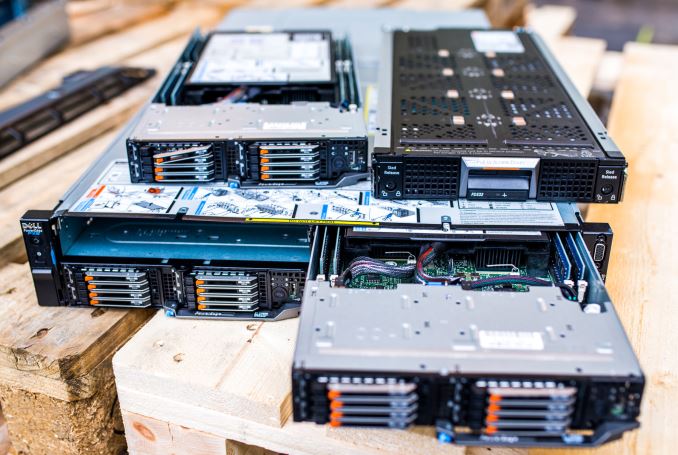The Evolution of HDDs in the Near Future: Speaking with Seagate CTO, Mark Re
by Anton Shilov on July 6, 2016 2:00 PM ESTNew 10K and 15K RPM HDDs Incoming
Hard drives with 10K and 15K spindle speeds are used to store mission-critical applications and data that also require high performance. Such drives typically use a SAS interface with its advantages over SATA/AHCI. Plenty of legacy systems and setups still rely on these fast hard drives, and as a result these systems are not going to be decommissioned in the near future. Nonetheless, the total available market for ultra-fast HDDs with 10K and 15K RPM spindle speeds has shrunk in the recent years due of SSDs. This does not mean that speedy HDDs no longer evolve - Seagate informed us that it is preparing another generation of 10K and 15K RPM HDDs.
Seagate’s new generation of 10K hard drives will not only feature 10K RPM spindle speed as per the name, but also TDMR technology — two readers per head. Those readers will read one track to improve signal to noise ratio and enable higher capacities. Keeping in mind that we are talking about critical storage applications, HDDs with two readers per arm will keep using PMR or SMR recording technology, but eventually the tech could be used for HAMR-based drives.
When it comes to 15K HDDs, Seagate seems to be somewhat more humble or secretive. The company did confirm that it is working on at least one more generation of 15K hard drives. The high-performance SAS deployments are already there and someone needs to serve them, which is where the next-generation 15K HDDs may come in handy. Moreover, SNIA has a long roadmap for SAS towards 24 Gb/s transfer speeds and the year 2020 ahead of it, which is why it is important for Seagate to offer both HDD and SSD solutions for this market. The next generation of 15K HDDs could be the last generation of such hard drives, which is why it will have to offer a balance of features and technologies that Seagate does not want to discuss at this time. Perhaps, not because of competitive reasons, but because it is working with its customers to enable features that they need.
Nonetheless, as new data center platforms arrive, the need for 15K HDDs will inevitably decrease and Seagate understands that. For example, Intel’s latest SSDs for mission-critical applications rely on PCIe bus and NVMe protocol. As a major provider of ultra-high-end Nytro storage accelerators, Seagate will naturally follow market’s trends, but this is a topic to be covered by an SSD-related conversation.











91 Comments
View All Comments
Zak - Wednesday, July 6, 2016 - link
Forget enterprise. I use 4GB drives as local backups and planning to go up to 6 or 8. Show me affordable 8TB SSD I can use for backup.inighthawki - Wednesday, July 6, 2016 - link
8TB no, but I'm sure I can find you a few good 4GB drives :)cm2187 - Wednesday, July 6, 2016 - link
WD Reds?cm2187 - Wednesday, July 6, 2016 - link
Actually even cheaper if it is for backups: seagate 8tb archive drives.Samus - Wednesday, July 6, 2016 - link
First off, GREAT article Anton. This is what AT is all about.I don't have a single HDD in my house anymore. Between 11TB on AWS and 800GB in OneDrive, it all comes down to the data centers which will all be using this technology.
Meanwhile the 480GB SSD's that cost $100 running my PC's and laptop have made magnetic storage irrelevant for my consumer use, so who can blame Seagate for not targeting me?
trivor - Thursday, July 7, 2016 - link
What everyone seems to be missing it NASes for the home with LARGE MEDIA collections. When you're looking at 2 GB for DVD rips and 4-5 GB for Blu Ray rips you need Terabytes of storage for $30/terabyte (or less hopefully) that SSDs can't touch. Even for full Blu Ray rips (some people want this) you're still looking at only needing 50 Mbps without any compression and even a lossless rip with Makemkv will take it down to 20 GB and will easily stream from a NAS with any decent spinning drive. When SSDs which are currently around $200/GB (for a consumer commercially available drive) to compete with spinning drives (say 3 TB @ $94 for a Toshiba or 3 TB for WD Red @ $109) then we won't see much in the consumer space. Not to even talk about 8 TB drives for around $200-$250. We are a long way from the demise of consumer spinning drives.CaedenV - Thursday, July 7, 2016 - link
No kidding! I love my SSDs, but they are not going in my Nas any time soon. I have 5 3tb drives in a raid 6...that would cost a mint in SSDs still. Maybe I'll get there eventually, but it is going to be a long time.Still, it is a sin to sell a pc with a hdd as a system drive these days. Really wish manufacturers would stop that
JlHADJOE - Wednesday, July 6, 2016 - link
IBM showed us that magnetic storage can store a bit using as few as 12 atoms. That's far denser than any type of memory developed so far.http://www.wired.com/2012/01/ibm-scientists/
SSDs will replace HDDs for most of the consumer market, but HDDs will stay around for bulk data.
Cygni - Wednesday, July 6, 2016 - link
It's 'ogre'? Is shrek around or something?Also if you read the article, you will see that this isn't exactly focused at the same market as enthusiast SSDs.
Michael Bay - Wednesday, July 6, 2016 - link
Tell that to 8Tb of media I have copying to the new HDD now.